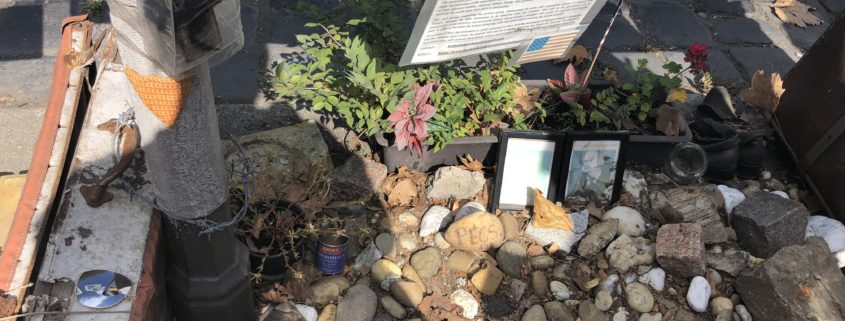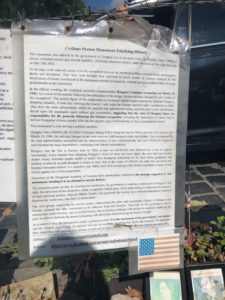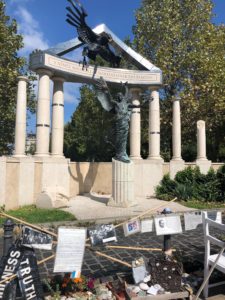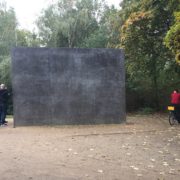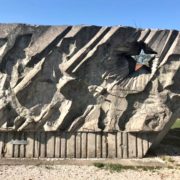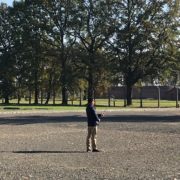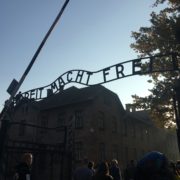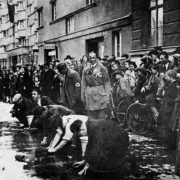Protesting a Memorial with Another Memorial: How Hungary Remembers Its Role in the Holocaust
By Meredith Conway
How can we accurately and fairly recount history? Who should be memorialized and who should not be? These questions ran like a constant thread throughout our first two weeks of traveling to four different cities. The first time I found myself trying to find answer these questions was after visiting Szabadsag (Freedom) Square in Budapest. We had already passed several monuments on our walking tour that I had, quite honestly, glazed over with indifference. However, when we walked up to the monument commemorating Germany’s occupation of Hungary in Freedom Square, I felt completely perplexed.
The monument itself depicts a menacing German imperial eagle hanging above a helpless Archangel Gabriel, symbolizing Hungary, who reaches his hand out to the eagle to offer the country’s orb. If you look at just this statue alone, it clearly conveys a message of Hungary as a total victim of German occupation. This would mean that any atrocities that occurred during occupation, say, the murdering of half a million Hungarian Jews by the end of WWII, was not a Hungarian decision but a German one. I knew this was not the truth. Hungary may have been occupied by Germany, but it still had its own puppet regime and welcomed German soldiers into its territory. Many Hungarians still held positions of power and were actively helping to murder their fellow Jewish citizens by transporting them to camps like Auschwitz or sending them on death marches. I couldn’t understand why this monument was here. I wondered if it had been erected shortly after the war. If it had been, I could rationalize it was only still here for strictly historical purposes and not for actual commemoration.
After initially looking at this gaudy display of false Hungarian victimhood, I looked down and around to see what was about eight feet in front of the monument. A path of stones and pebbles five inches wide lined the monument. On the stones were pictures, suit cases, shoes and an assortment of other mementos from Hungarian Jewish victims of the holocaust. Above the stones was a barbed wire fence with more pictures, documents and sheets of typed paper hanging on the wire. Each sheet of typed paper, twelve in total, had a different country’s flag in the bottom right corner, indicating the language it was written in. Already confused by why this monument still existed because of its inaccuracies, and now even more confused by the purpose of this stone path, I walked up to the sheet with the American flag to learn more.
As I read the title of the paper, “Citizens Protest Monument Falsifying History”, some of my confusion was replaced with amazement. The stone path and mementos were a counter memorial created by local citizens. They wrote the same paper in several different languages to inform tourists and visitors the truth about Hungary’s role in the extermination of its Jewish people. They also condemned the Budapest government for assembling this deceitful monument in the dead of night on July 20, 2014; This was an act that showed a clear disregard for citizens’ dissenting opinions over the monument. Towards the end of the paper, the protestors proclaimed that by erecting this monument the government is “making a concession to Hungary’s far right: the advocates of the nationalist, racist, xenophobic Jobbik party” and demanded its removal.
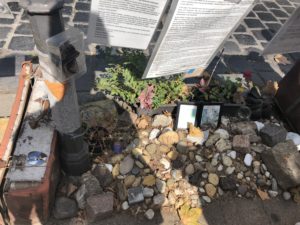
Mementos and pictures of Hungarian Jewish holocaust victims brought by citizens which are a part of the counter memorial.
So, this monument was not here for strictly historical purposes as I had hoped. But, I was no longer standing in front of a memorial that white-washed history like I had originally believed. I was witnessing a peaceful protest. I was learning about people who refused to let their government inaccurately remember their history. Even more amazing was the fact that these people were not historians or academics distributing this piece of writing in 12 different languages or bringing objects of their lost ancestors. These were just citizens who felt compelled to tell other citizens and non-citizens alike the truth about their history and their government. As I walked down the path to look at pictures and relics, I couldn’t help but feel a sense of pride and admiration for these brave citizens who made this possible. At the same time, I was unnerved. How could the government choose to completely ignore the wishes of its citizens and not remove the monument? Why was the government okay with letting tourists like myself see this counter memorial and learn about its concession to the far right? The complacency was baffling.
The counter memorial created by the Hungarian citizens reminded me while history is the past, how it is recounted in the present, whether accurately or inaccurately, is the choice of those living in that moment. These citizens chose to remember the Hungarian Jews who were murdered by their own government when that same government chose to try to forget about them almost eighty years later. Though I always strive to be optimistic, I doubt the monument in Freedom Square will be removed any time soon. But, I find comfort in knowing as long as that fictitious monument is there, the real monument will be there as well.

